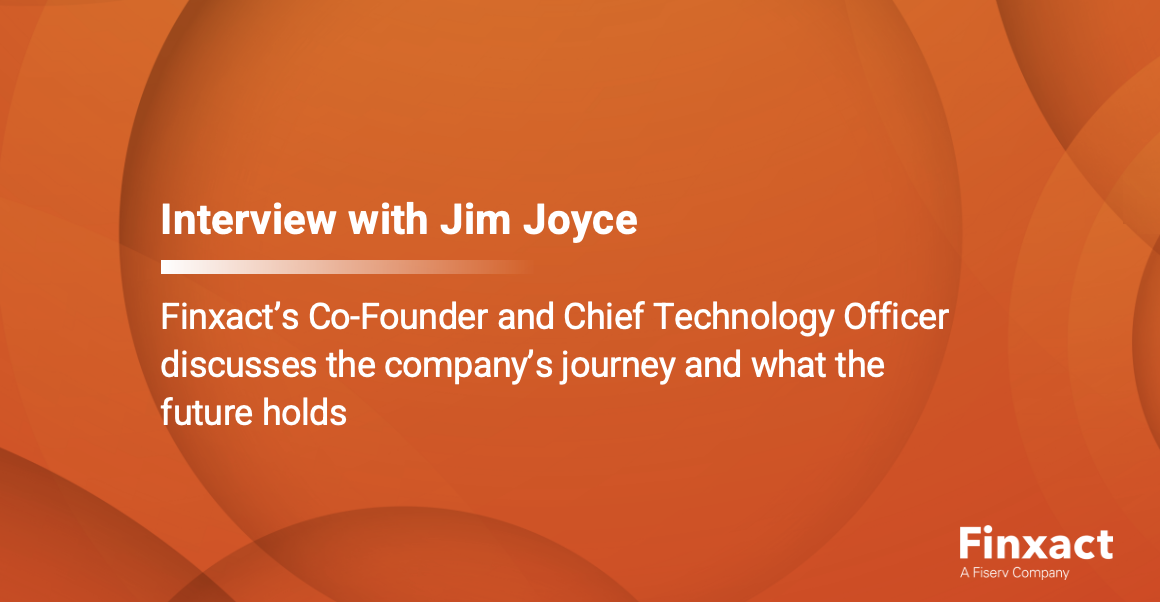- Platform
- Partners
- Resources
- About
- Teaser1
- Teaser2
- Teaser3
- Teaser1
- Teaser2
- Teaser3
- Teaser1
- Teaser3
- Teaser2
PARTNERS
Industry Insights
January 11, 2023 • 7 mins read

Jim Joyce
Co-Founder and Finxact CTO
Finxact

Industry Insights
January 11, 2023 • 7 mins read

Jim Joyce
Co-Founder and Finxact CTO
Finxact
Finxact CMO Christopher McClinton recently caught up with Finxact Co-Founder and Chief Technology Officer Jim Joyce about the company journey, lessons learned, and what the future holds for both Finxact and the CTO himself.
You are one of Finxact’s founders and have been CTO since its inception. What has been the most gratifying aspect of the journey thus far? What has been the most challenging?
There are a lot of things that are very gratifying so it’s hard to pick one that’s most gratifying, but I would say seeing partners and customers use our product to build banking experiences and deliver them to consumers has been amazing. It’s amazing to think that five years ago nothing existed and now it’s in production and in the hands of some very innovative banks and Fintechs.
The most challenging aspect has been growing the company at the unprecedented pace we’ve been asked to scale it. Finxact is built on an entirely new technology platform. Unique subject matter expertise is needed to develop core banking functionality, and it takes someone who is quick to learn and highly motivated to get up to speed. At the same time, it’s been incredible to see new teammates join the journey along the way and see their new ideas and designs elevate our product. So in that sense, I think our biggest challenge is often the most rewarding.
Finxact has always self-identified as an engineering company. What impact or influence has that had on the company culture?
Core banking is about precision and reliability. For banks, accuracy and stability are the most important features of the core banking system. A company is made up of people and people are not perfect, but by having an engineering culture we can acknowledge our imperfections and rely on the first principles of engineering and design to help us deliver a product that meets the incredibly demanding requirements of financial institutions.
We are not able to name brand names just yet, but Finxact is being asked to demonstrate its ability to scale to support a massive number of accounts on its platform, with all of the concurrent transaction processing, eventing, reporting, logging, regional redundancy and other activity that account activity implies. Two questions then… how is that going thus far, and what have you done organizationally to build that capacity?
We need to be able to process 150 million positions in a single instance of the core and we are fast approaching that target in benchmark testing. Performance and stability fit hand in glove. Many defects occur only at scale, and you can’t uncover those edge case issues if you can’t consistently run performance and benchmark tests early in the development process. This year we created a new team run by our SVP of Software Architecture, Mike O’Toole, that is purely dedicated to performance testing and improvements. The performance team has made great strides in gaining deeper visibility to the core across all components which has led to significant improvements. Additionally, we have identified several architectural improvements which we believe are critical to achieving the target scale while improving stability even further.
One of the implications of being a real-time, cloud-native core is the DevOps culture that engenders at a company. In your words, explain DevOps and the unique discipline and skill sets it requires in hiring.
Early in my career, I worked in both development and operations. Development teams had processes and tools to ensure that the code went through quality control and security processes efficiently. At that time, operations were largely manual. Operators would write scripts to automate tasks, but those scripts tended to be loosely managed and prone to operator mistakes. In the last 15-20 years the concept of DevOps emerged as operations teams adopted mature software development practices like configuration management and automated pipelines. More recently DevOps has become a bit of an umbrella term that describes all the things that happen between the developer writing the program to the moment that it’s up and running in a production environment.
For Finxact, the emphasis is on DevOps for applications and services that are authored by Finxact. So, it is important for our DevOps teams to understand the unique needs of the Finxact Core in addition to the widely used cloud technologies that we leverage. On top of that, Finxact is multi-cloud. DevOps architects and engineers at Finxact need to quickly pick up new technologies, understand how they work across different cloud providers, and deliver them at production scale.
There is a heated race afoot among the very few next-gen core providers that are considered credible for the US market. Finxact, however, remains, for now, the only next-gen platform in production in the US, now for 14 clients. What does ‘production hell’ teach a company in the core banking business, and why are there lessons that you can only learn there?
I don’t think we’re in ‘production hell’ anymore, but there certainly was a time when the challenges we faced in production had a severe impact on the lives of the people at Finxact responsible for developing and supporting the system. Being live in production has a significant impact across the whole company in very positive ways. It’s where we get our revenue. But the trying times and hard lessons of production are how we perfect the Finxact core. Defects and incidents are opportunities to learn from past mistakes and make good on them.
One of our major areas of focus is continuous delivery. You may be familiar with the term ‘Continuous Integration, Continuous Delivery’ (CI/CD). Because the Finxact Core is delivered as a service, CI/CD is a fundamental part of the product. We develop new features every day. Architectural improvements are added very frequently, some of which have a deep-reaching impact on the underlying operation of the core. It is critically important that we continue to deliver these features without interrupting production activity.
It’s a tough climate for fintech startups out there lately. What advice might you have for the management team of a young company that is about where Finxact was 5 years ago in terms of maturity?
The best advice I have for a young company’s management team is to stay focused on your original objectives. Finxact is very fortunate to have someone like Frank Sanchez as CEO, a brilliant engineering mind with incredible focus. People attracted to startups have a deep desire to solve problems and new problems present themselves as ‘opportunities’ every day in a startup. If you can’t look objectively at these ‘opportunities’ and determine if it’s a priority for your mission, you will quickly go off track and may never meet your objectives. It is impossible to stay completely on track 100% of the time. Your original vision will encounter friction that can be solved no other way but to concede to do things that you had not originally intended to do. You need to recognize that you will pay a price for those decisions down the road, so you need to consider carefully the implications and the potential trade-offs. Whatever you call it, it’s the things that can put your business at risk but it’s largely within your control if you can stay focused.
Finxact is now a Fiserv company. That combination has some obvious advantages, most notably, pairing Finxact’s next-gen technology with Fiserv’s organizational depth and maturity. What are some surprising aspects of this partnership that you’ve observed thus far, that you did not perhaps anticipate, and how do you see customers benefiting?
Well, I was highly confident that we were making the right decision to be acquired earlier this year. Through that process, I worked very closely with several people within Fiserv and we quickly developed a very high degree of trust and a shared vision for the future of Finxact. Not surprisingly, that level of trust and shared vision continues to hold strong. What has surprised me is the genuine enthusiasm for Finxact across the many Fiserv team members that I’ve met as we’re building integrations and a ‘go-to-market’ solution with Finxact and Fiserv products. Fiserv is a very large organization and there are a lot more people to meet but the trust and camaraderie across all the Fiserv teams remains consistent.
I reflect on the earliest days of the Finxact acquisition; I was at an ABA conference being interviewed on stage with a number of other CTOs and CEOs. Frank Bisignano, Chairman and CEO of Fiserv, was there on stage. What struck me was the sincerity of his words and tone when he made it clear to the audience that he wanted Fiserv to be a better partner to the banks by having better contract terms and delivering better technology through Finxact and the other investments Fiserv was making. Frank Bisignano’s message reinforced what I had already come to learn about Fiserv and its leadership team: customers deserve respect, fair business partners and the best technology we can deliver to support their business goals.
What’s next for Jim Joyce?
One of my favorite quotes is by Enzo Ferrari and I keep it above my desk. It reads, ‘the best Ferrari is the one that we haven’t made yet’. To think that of all the incredible cars Ferrari had built, he believed the best is yet to come. This is what I believe for Finxact. We have created an amazing company, platform, and product, but what we do in the future will be our greatest achievement. The next set of features, the next architectural improvement, the next automation we build in DevOps, the next innovative use of our APIs we deliver to our partners and customers; that is the best of Finxact and the best is yet to come. These improvements will open the door to even bigger opportunities for Finxact. It will open up new markets in the US and internationally. So, for me personally, what’s next, if I’m lucky, is to be part of the design, development, support, and client success on the constantly improving Finxact platform.
XTNSBL
More Insights
and Updates
The future of banking - next generation platform









 Tom Eck, SVP/CIO of Digital Transformation, Fiserv
Tom Eck, SVP/CIO of Digital Transformation, Fiserv

 Cooper Thompson, VP of Finxact's Innovation Center, Fiserv
Cooper Thompson, VP of Finxact's Innovation Center, Fiserv